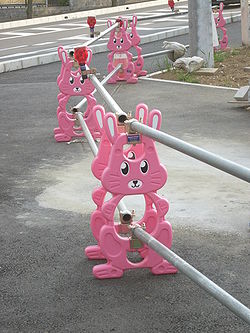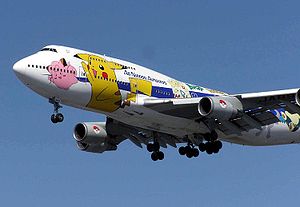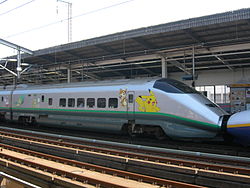- Cuteness in Japanese culture
-
"Kawaii" redirects here. For various uses of Kawai, see Kawai (disambiguation). For the Hawaiian island, see Kauai.
Since the 1970s, cuteness, in Japanese the noun[1] kawaisa (可愛さ) (literally, "lovability", "cuteness" or "adorableness"), has become a prominent aspect of Japanese popular culture, entertainment, clothing, food, toys, personal appearance, behavior, and mannerisms.[2] The adjective[3] is kawaii (可愛い)[4] (literally, "lovable", "cute",[5] or "adorable"[6]).
The words "kawaisa" and "kawaii" have the root word "kawai" which is formed from the kanji "ka" (可), meaning "acceptable", and "ai" (愛), meaning "love". The term kawaii has taken on the secondary meanings of "cool,"[7] "groovy,"[7] "acceptable,"[8] "desirable,"[8] "charming"[9] "non-threatening".[9]
Contents
Aesthetics
Sōichi Masubuchi 増渕聡一 (Masubuchi Sōichi) in his work, Kawaii Syndrome, claims "cute" and "neat" have taken precedence over the former Japanese aesthetics of "beautiful" and "refined".[9]
Performativity
Japanese women who feign cute behaviors (e.g., high-pitched voice, squealing giggles[10]) that could be viewed as forced or inauthentic are called burikko and this is considered a gender performance.[11] The term burikko (鰤子) is formed with buri (鰤, literally ‘amberjack’ a fish), a pun on furi (‘to pretend or pose’)[12], and ko (子, ‘child’).[11] It was a neologism developed in the 1980s by singer Kuniko Yamada 山田邦子 (Yamada Kuniko).[11]
Physical attractiveness
In Japan, cuteness is expected of men and women.[13] There is a trend of men shaving their legs to mimic the "asexual" look.[13] Many Japanese men are drawn to the owner of cute merchandise, because it is reminiscent of little girls,[14] and Japanese women try to act cute to attract men.[13] A study by Kanebo, a cosmetic company, found that Japanese women in their 20s and 30s favored the "cute look" with a "childish round face".[8]
History
Original definition
The original definition of kawaii came from Lady Murasaki's The Tale of Genji where it referred to pitiable qualities.[9] During the Shogunate period under the ideology of neo-Confucianism, women came to be included under the term kawaii as the perception of women from being animalistic was replaced with the conception of women as docile.[9]
Cute handwriting
The rise of cuteness in Japanese culture emerged in the 1970s as part of a new style of writing.[15] Many teenage girls began to write laterally using mechanical pencils.[15] These pencils produced very fine lines, as opposed to traditional Japanese writing that varied in thickness and was vertical.[15] Also, the girls would write in big, round characters and they added little pictures to their writing, such as hearts, stars, smiley faces, and letters of the Latin alphabet.[15]
These pictures would be inserted randomly and made the writing very hard to read.[15] As a result, this writing style caused a lot of controversy and was banned in many schools.[15] During the 1980s, however, this new "cute" writing was adopted by magazines and comics and was put onto packaging and advertising.[15]
From 1984–1986, Kazuma Yamane 山根和麻 (Yamane Kazuma ) studied the development of cute handwriting, which he called Anomalous Female Teenage Handwriting, in depth.[15] This type of cute Japanese handwriting has also been called: marui ji (丸い字), meaning "round writing," koneko ji (小猫字), meaning "kitten writing," manga ji (漫画字), meaning "comic writing," and burikko ji (鰤子字), meaning "fake-child writing"[16] Although it was commonly thought that the writing style was something that teenagers had picked up from comics, he found that teenagers had come up with the style themselves, as part of an underground movement.[15]
Cute fashion
Tomoyuki Sugiyama 杉山奉文 (Sugiyama Tomoyuki), author of Cool Japan, claims cute fashion in Japan can be traced back to the Edo Period with the popularity of netsuke. [8]
Because of this growing trend, companies such as Sanrio came out with merchandise like Hello Kitty. Hello Kitty was an immediate success and the obsession with cute continued to progress in other areas as well. The 1980s also saw the rise of cute idols, such as Seiko Matsuda, who is largely credited with popularizing the trend. Women began to emulate Seiko Matsuda and her cute fashion style and mannerisms, which emphasized the helplessness and innocence of young girls.[17] The market for cute merchandise in Japan is driven by Japanese girls between 15 and 18 years old.[18]
No longer limited to teenagers, however, the spread of making things as cute as possible, even common household items, was embraced by people of all ages. Now there are airplanes painted with Pokémon characters on the side, and each of Japan’s 47 prefectures, the Tokyo police, and even the public broadcaster NHK all have their own cute mascots. Domokun, the unique-looking and widely recognized NHK mascot, was introduced in 1998 and quickly took on a life of its own, appearing in Internet memes and fan art around the world. Currently, Sanrio’s line of more than 50 characters takes in more than $1 billion a year and it remains the most successful company to capitalize on the cute trend.[14]
Cute characters
Cute elements can be found almost everywhere in Japan, from big business to corner markets and national government, ward, and town offices.[14][13] Many companies, large and small, use cute mascots to present their wares and services to the public. For example:
- Pikachu, a character from Pokémon, adorns the side of three ANA passenger jets.
- Asahi Bank used Miffy (Nijntje), a character from a Dutch series of children's picture books, on some of its ATM and credit cards.
- All 47 prefectures have cute mascot characters.[citation needed]
- The Japan Post "Yū-Pack" mascot is a stylized mailbox;[19] they also use other cute mascot characters to promote their various services (among them the Postal Savings Bank) and have used many such on postage stamps.
- Some police forces in Japan have their own moe mascots, which sometimes adorn the front of kōban (police boxes).
- Sanrio, the company behind Hello Kitty and other similarly cute characters, runs the Sanrio Puroland theme park in Tokyo.
Cute can be also used to describe a specific fashion sense[20][7] of an individual, and generally includes clothing that appears to be made for young children, apart from the size, or clothing that accentuates the cuteness of the individual wearing the clothing. Ruffles and pastel colors are commonly (but not always) featured, and accessories often include toys or bags featuring anime characters.[14]
Popular cute characters in Japan
These cute characters are popular in Japan: Tarepanda,[14]Hello Kitty,[14] Momo the Postpet,[14] Felix the Cat,[14] Pingu,[14] Mickey Mouse,[14] Stitch, Marie, Chip 'n Dale, Teletubbies,[14] Snoopy,[13] Winnie-the-Pooh,[13] Miffy,[13] Rilakkuma,[21] Mameshiba,[22] Care Bears, Care Bear Cousins, Popples, Hamtaro, Pikachu, Totoro, Doraemon and Oswald the Lucky Rabbit[23]
Cute in Western countries but not in Japan
Cabbage Patch Kids dolls did not sell well in Japan, because the Japanese considered their facial features to be "ugly" and "grotesque" compared to the flatter and almost featureless face of Hello Kitty.[9] Also, Barbie did not become successful in Japan compared to the Rika-chan doll who was modeled after a pre-pubescent girl.[9]
Perception in Japan
As a cultural phenomenon, cuteness is increasingly accepted in Japan as a part of Japanese culture and national identity. Tomoyuki Sugiyama 杉山奉文 (Sugiyama Tomoyuki), author of "Cool Japan", believes that "cuteness" is rooted in Japan's harmony-loving culture, and Nobuyoshi Kurita 栗田経惟 (Kurita Nobuyoshi), a sociology professor at Musashi University in Tokyo, has stated that "cute" is a "magic term" that encompasses everything that's acceptable and desirable in Japan.[24]
Influence on other cultures
Cute merchandise and products are especially popular in some other parts of East Asia, such as China, Hong Kong, South Korea, Singapore, Taiwan and Thailand.[14][25]
Japan's global image has shifted from being known for austere rock gardens to being known for "cute-worship".[8]
See also
- Culture of Japan
- Japanese popular culture
- Japanese street fashion
- Beauty
- Moe
- Lolita fashion
- Cool Japan
- Escapism
- Feminization (sociology)
References
- ^ A Video Gamers Guide to Japanese. Japanese Basic Grammar. Accessed May 7, 2011, from http://www.geocities.ws/japanese4vg/grammar.html
- ^ Diana Lee, "Inside Look at Japanese Cute Culture" (September 1, 2005).
- ^ Kim, T. Beautiful is an Adjective. Accessed May 7, 2011, from http://www.guidetojapanese.org/adjectives.html
- ^ かわいい - kawaii - 可愛い - cute Japanesefile. Accessed May 7, 2011 from http://japanesefile.com/Adjectives/kawaii_3.html
- ^ Ashlstrom, K. Denshi Jisho — Online Japanese dictionary. "kawaii". Accessed May 7, 2011, from http://jisho.org/words?jap=kawaii&eng=&dict=edict
- ^ [1] _The Japanese Self in Cultural Logic_ by Takei Sugiyama Libre, c. 2004 University of Hawaii Press, ISBN 0824828402, p. 86.
- ^ a b c Time Asia: "Arts: Kwest For Kawaii". Retrieved on 2006-04-19 from http://www.time.com/time/asia/arts/magazine/0,9754,131022,00.html.
- ^ a b c d e TheAge.Com: "Japan smitten by love of cute" http://www.theage.com.au/news/people/cool-or-infantile/2006/06/18/1150569208424.html
- ^ a b c d e f g Shiokawa. "Cute But Deadly: Women and Violence in Japanese Comics". Themes and Issues in Asian Cartooning: Cute, Cheap, Mad and Sexy. Ed. John A. Lent. Bowling Green, Kentucky: Bowling Green State University Popular Press, 1999. 93–125. ISBN 0-87972-779-9.
- ^ Merry White (29 September 1994). The material child: coming of age in Japan and America. University of California Press. pp. 129. ISBN 9780520089402. http://books.google.com/books?id=vom1N-653voC&pg=PA129. Retrieved 19 July 2011.
- ^ a b c "You are doing burikko!: Censoring/scrutinizing artificers of cute femininity in Japanese," Laura Miller in Gender, and Ideology: Cultural Models and Real People, edited by Janet Shibamoto Smith and Shigeko Okamoto, Oxford University Press, 2004. In Japanese.
- ^ Mitsubishi Shōji Kabushiki Kaisha (25 April 1988). Tatemae and honne: distinguishing between good form and real intention in Japanese business culture. Free Press. p. 67. ISBN 9780029215913. http://books.google.com/books?id=cXwEAQAAIAAJ. "A similar word in vogue today is burikko, which is a contraction of "a girl (ko) who puts on (furi = buri) a cute pose.""
- ^ a b c d e f g Business Week, "In Japan, Cute Conquers All".
- ^ a b c d e f g h i j k l "Cute Inc.". WIRED. December 1999. http://www.wired.com/wired/archive/7.12/cute.html.
- ^ a b c d e f g h i Kinsella, Sharon. 1995. "Cuties in Japan" [2] accessed August 1, 2009.
- ^ Skov, L.(1995). Women, media, and consumption in Japan. Hawai'i Press, USA.
- ^ See [3] URL accessed February 11, 2009.
- ^ Time Asia: Young Japan: She's a material girl http://www.time.com/time/asia/asia/magazine/1999/990503/style1.html
- ^ Japan Post site showing mailbox mascot. URL accessed April 19, 2006.
- ^ The New Yorker "FACT: SHOPPING REBELLION: What the kids want". Retrieved on 2006-04-19 from http://www.newyorker.com/fact/content/?020318fa_FACT.
- ^ Kirin On. (2009). Tokyo kawaii etc. Rilakkuma Story in Tokyo. Retrieved May 25, 2011, from http://tokyokawaiietc.com/archives/2121
- ^ Japangasm. (2010). Mameshiba! Retrieved May 25, 2011, from http://japangasm.wordpress.com/2010/05/25/mameshiba/
- ^ Jerry. 2005. Oswald Mania in Japan. Cartoon brew. http://www.cartoonbrew.com/old-brew/oswald-mania-in-japan.html
- ^ Quotes and paraphrases from: Yuri Kageyama (June 14, 2006). "Cuteness a hot-selling commodity in Japan". Associated Press. http://www.washingtonpost.com/wp-dyn/content/article/2006/06/14/AR2006061401122.html.
- ^ Cute Power! Asia Is In Love With Japan's Pop Culture. From Pokemon To Puffy, Japanese Stuff Is Oh, So 'Q!' Stock Up On Those Hello Kitty Dumplings.
Aesthetics Philosophers Theodor W. Adorno · Hans Urs von Balthasar · Alexander Gottlieb Baumgarten · Clive Bell · Bernard Bosanquet · Edward Bullough · R. G. Collingwood · Arthur Danto · John Dewey · Hubert Dreyfus · Curt John Ducasse · Thierry de Duve · Roger Fry · Nelson Goodman · Georg Hegel · Martin Heidegger · David Hume · Immanuel Kant · Paul Klee · Susanne Langer · Theodor Lipps · György Lukács · Jean-François Lyotard · Joseph Margolis · Jacques Maritain · Thomas Munro · Friedrich Nietzsche · José Ortega y Gasset · Dewitt H. Parker · Stephen Pepper · David Prall · I. A. Richards · George Santayana · Friedrich Schiller · Arthur Schopenhauer · Irving Singer · Richard Wollheim · more...Theories Concepts Aesthetic emotions · Aesthetic interpretation · Art manifesto · Avant-garde · Beauty · Boredom · Camp · Comedy · Creativity · Cuteness · Disgust · Ecstasy · Elegance · Entertainment · Eroticism · Gaze · Harmony · Judgement · Kitsch · Life imitating art · Magnificence · Mimesis · Perception · Quality · Rasa · Reverence · Style · Sublime · Taste · Work of art · more...Related topics Aesthetics of music · Applied aesthetics · Architecture · Art · Arts criticism · Gastronomy · History of painting · Humour · Japanese aesthetics · Literary merit · Mathematical beauty · Mathematics and art · Painting · Philosophy of film · Philosophy of music · Poetry · Sculpture · Theory of painting · TragedyCategories:- Japanese aesthetics
- Japanese culture
- Japanese pop culture
- Japanese fashion
Wikimedia Foundation. 2010.



